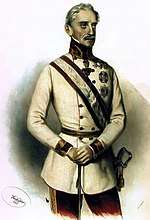Alfred I, Prince of Windisch-Grätz
General[1] Alfred Candidus Ferdinand, Prince of Windisch-Grätz (German: Alfred Candidus Ferdinand Fürst zu Windisch-Grätz; 11 May 1787 – 21 March 1862), a member of the Bohemian noble Windisch-Graetz family, was a Field Marshal in the Austrian army. He is most noted for his service during the Napoleonic Wars and for his role in suppressing the Revolutions of 1848 in the Austrian Empire.
General[1] Prince Alfred Candidus Ferdinand zu Windisch-Graetz | |
|---|---|
 Prince Windisch-Graetz in an 1852 lithograph | |
| Born | 11 May 1787 Brussels, Austrian Netherlands |
| Died | 21 March 1862 (aged 74) Vienna, Austrian Empire |
| Allegiance | |
| Battles/wars | Battle of Leipzig (1813) Battle of Pákozd (1848) Battle of Schwechat (1848) Battle of Komárom (1849) Battle of Segesvár (1849) |
Alfred I | |
|---|---|
| Prince of Windisch-Grätz | |
| Born | 11 May 1787 Brussels, Austrian Netherlands |
| Died | 21 March 1862 (aged 74) Vienna |
| Noble family | Windisch-Graetz |
| Spouse(s) | Princess Eleonore of Schwarzenberg |
| Father | Joseph Nicholas of Windisch-Graetz |
| Mother | Duchess Maria Leopoldine Franziska of Arenberg |
Background
Originally from Styria, the Windisch-Graetz dynasty had received Inkolat rights of nobility by the Bohemian Crown in 1574. Alfred was born in Brussels, then capital of the Austrian Netherlands, the son of Count Joseph Nicholas of Windisch-Graetz (1744–1802) and his second wife, Duchess Maria Leopoldine Franziska of Arenberg. The family took its residence at Tachau (Tachov), the lordship had been purchased by Alfred's father in 1781.
On 15 June 1817 he married Princess Eleonore of Schwarzenberg.
Napoleon
He started service in the Habsburg imperial army in 1804. As an Austrian army officer he distinguished himself throughout the wars fought by the Habsburg Monarchy in the 19th century.
Windisch-Grätz participated in all the wars against Napoleon and fought with distinction at the Battle of Leipzig and in the campaign of 1814.[2] In 1833, he was named Lieutenant Field Marshal (made Field Marshal (German: Feldmarschall) in October 1848).
Bohemia
In the years of peace that followed, Windisch-Grätz held commands in Prague, being appointed head of the army in Bohemia in 1840. Having gained a reputation as a champion of energetic measures against revolution, during the Revolutions of 1848 in Habsburg areas he was called upon to suppress the March 1848 insurrection in Vienna. However, finding himself ill-supported by government ministers he resigned from his post.[2]
After returning to Prague, his wife was killed by a stray bullet during the popular uprising.[3] He then showed firmness in quelling an armed outbreak of the Czech separatists (June 1848), declaring martial law throughout Bohemia. Upon the recrudescence of revolt in Vienna he was summoned to head a large army that reduced the city through a formal siege by October 1848.[2]
Hungary
Appointed to the chief command against the Hungarian revolutionaries under Lajos Kossuth, he gained some early successes and reoccupied Buda and Pest (January 1849), but by his slowness in pursuit he allowed the enemy to rally in superior numbers and to prevent an effective concentration of the Austrian forces.[2]
In April 1849 he was relieved of his command and thereafter rarely appeared again in public life.[2]
Quotes
(In reference to rebellious constitutionalists) "They do not want to hear about the Grace of God? They will hear the grace of the cannon."
Ancestry
| Ancestors of Alfred I, Prince of Windisch-Grätz | ||||||||||||||||||||||||||||||||||||||||||||||||||||||||||||||||||||||||||||||||||||||||||||||||||||||||||||||||||||||||||||||||||||||||||||||||||||||||||||||||||||||||||||||||||||||||||||||||||||||||||||||||||||||||||||||||||||||||||||||||||||||||||||||||||||||||||||||||||||||||||||||||||||||||||||||||||||||||||||||||||||||||||||||||||||||||||||||||||||||||||||||||||||||||||||||||||||||||||||||||||||||||||||||||||||||||||||||||||||||||||||||||||||||||||||||||||||||||||||||||||||||||||||||||||||||||||||||||||||||||||||||||||||||||||||||||||||||||||||||||||||||||||||||||||||||||||||||||
|---|---|---|---|---|---|---|---|---|---|---|---|---|---|---|---|---|---|---|---|---|---|---|---|---|---|---|---|---|---|---|---|---|---|---|---|---|---|---|---|---|---|---|---|---|---|---|---|---|---|---|---|---|---|---|---|---|---|---|---|---|---|---|---|---|---|---|---|---|---|---|---|---|---|---|---|---|---|---|---|---|---|---|---|---|---|---|---|---|---|---|---|---|---|---|---|---|---|---|---|---|---|---|---|---|---|---|---|---|---|---|---|---|---|---|---|---|---|---|---|---|---|---|---|---|---|---|---|---|---|---|---|---|---|---|---|---|---|---|---|---|---|---|---|---|---|---|---|---|---|---|---|---|---|---|---|---|---|---|---|---|---|---|---|---|---|---|---|---|---|---|---|---|---|---|---|---|---|---|---|---|---|---|---|---|---|---|---|---|---|---|---|---|---|---|---|---|---|---|---|---|---|---|---|---|---|---|---|---|---|---|---|---|---|---|---|---|---|---|---|---|---|---|---|---|---|---|---|---|---|---|---|---|---|---|---|---|---|---|---|---|---|---|---|---|---|---|---|---|---|---|---|---|---|---|---|---|---|---|---|---|---|---|---|---|---|---|---|---|---|---|---|---|---|---|---|---|---|---|---|---|---|---|---|---|---|---|---|---|---|---|---|---|---|---|---|---|---|---|---|---|---|---|---|---|---|---|---|---|---|---|---|---|---|---|---|---|---|---|---|---|---|---|---|---|---|---|---|---|---|---|---|---|---|---|---|---|---|---|---|---|---|---|---|---|---|---|---|---|---|---|---|---|---|---|---|---|---|---|---|---|---|---|---|---|---|---|---|---|---|---|---|---|---|---|---|---|---|---|---|---|---|---|---|---|---|---|---|---|---|---|---|---|---|---|---|---|---|---|---|---|---|---|---|---|---|---|---|---|---|---|---|---|---|---|---|---|---|---|---|---|---|---|---|---|---|---|---|---|---|---|---|---|---|---|---|---|---|---|---|---|---|---|---|---|---|---|---|---|---|---|---|---|---|---|---|---|---|---|---|---|---|---|---|---|---|---|---|---|---|---|---|---|---|---|---|---|---|---|---|---|---|---|---|---|---|---|---|---|---|---|---|---|---|---|---|---|---|---|---|---|---|---|---|---|---|---|---|---|---|---|---|---|---|---|---|---|---|---|---|---|---|---|---|---|---|---|---|---|---|---|---|---|---|---|---|---|---|---|---|---|---|---|---|---|---|---|---|---|---|---|---|---|---|---|---|---|---|---|---|---|---|---|---|---|---|---|---|---|---|---|---|---|---|---|---|---|---|---|---|---|---|---|---|---|---|---|---|---|---|---|---|---|
| ||||||||||||||||||||||||||||||||||||||||||||||||||||||||||||||||||||||||||||||||||||||||||||||||||||||||||||||||||||||||||||||||||||||||||||||||||||||||||||||||||||||||||||||||||||||||||||||||||||||||||||||||||||||||||||||||||||||||||||||||||||||||||||||||||||||||||||||||||||||||||||||||||||||||||||||||||||||||||||||||||||||||||||||||||||||||||||||||||||||||||||||||||||||||||||||||||||||||||||||||||||||||||||||||||||||||||||||||||||||||||||||||||||||||||||||||||||||||||||||||||||||||||||||||||||||||||||||||||||||||||||||||||||||||||||||||||||||||||||||||||||||||||||||||||||||||||||||||
References
- Farwell, Byron (2001). The Encyclopedia of Nineteenth-century Land Warfare: An Illustrated World View (Illustrated ed.). W. W. Norton & Company. p. 450. ISBN 0393047709.
-

- Reuben J. Rath, The Viennese Revolution of 1848 (New York, 1969), p.261
Bibliography
- Fürst Windischgrätz. Eine Lebensskizze. Aus den Papieren eines Zeitgenossen der Sturm-Jahre 1848 und 1849 (2nd ed., Leipzig, 1898)